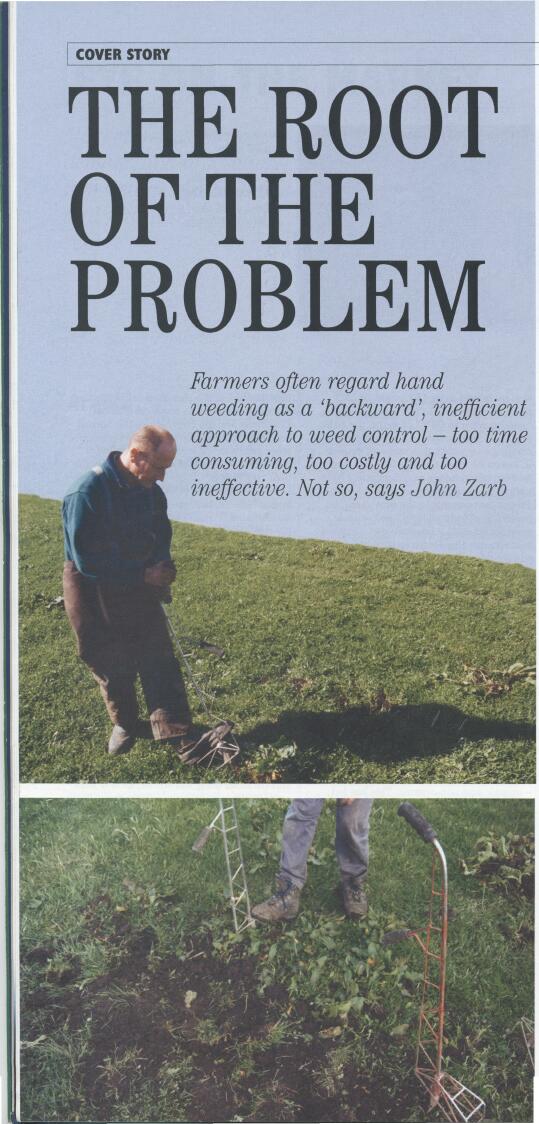
Like it or not,
weeds are a part of
organic farming. Indeed, they should
be seen as an important component
of the farm.
organic farming. Indeed, they should
be seen as an important component
of the farm.
As long ago
as 50 years, progressive
farmers and commentators, such as
Newman Turner, Albert Howard and
Lady Eve Balfour, went to some length
to highlight the value of farmland weeds
to a sceptical new generation of modern
farmers, seduced by the promise of
chemical herbicides.
farmers and commentators, such as
Newman Turner, Albert Howard and
Lady Eve Balfour, went to some length
to highlight the value of farmland weeds
to a sceptical new generation of modern
farmers, seduced by the promise of
chemical herbicides.
The value of weeds
Newman Turner
used chickweed and
groundsel as green manure, lightly discing
the plants before they set seed. He over-
wintered stock on weedy cereal stubble,
feeding ad lib oat or barley straw in the
field. And he mowed cereal field margins
for silage before combining.
groundsel as green manure, lightly discing
the plants before they set seed. He over-
wintered stock on weedy cereal stubble,
feeding ad lib oat or barley straw in the
field. And he mowed cereal field margins
for silage before combining.
Weeds have vital
ecological and aesthetic
value as green manures, forage, seed, food,
habitat and soil cover, and as sources of
genetic biodiversity - all key factors in
organic farming systems. Having said that,
some weeds like ragwort, spear thistle,
creeping thistle and dock can be serious
problems in grass and arable crops. And as
they are listed as injurious weeds under the
1959 Weeds Act they must be controlled in
any case.
value as green manures, forage, seed, food,
habitat and soil cover, and as sources of
genetic biodiversity - all key factors in
organic farming systems. Having said that,
some weeds like ragwort, spear thistle,
creeping thistle and dock can be serious
problems in grass and arable crops. And as
they are listed as injurious weeds under the
1959 Weeds Act they must be controlled in
any case.
In an age where
we are conditioned
to think that only technological solutions
are desirable, and where any kind of manual
labour smacks of 'backwardness', we have
shown that manual work is an efficient and
cost effective method of controlling weeds
when integrated with other weed control
measures - provided you have the right
tools and the right approach.
to think that only technological solutions
are desirable, and where any kind of manual
labour smacks of 'backwardness', we have
shown that manual work is an efficient and
cost effective method of controlling weeds
when integrated with other weed control
measures - provided you have the right
tools and the right approach.
Necessity, mothers and invention
Philip Trevelyan
produces organic
cereals and sheep on his own land, and
grazes organic sheep on common land at
Spaunton, North Yorkshire. Faced with the
problem of ragwort and thistle control on
large areas also grazed by neighbouring
farmers, he was compelled to come up
with weed control methods that would not
compromise his organic status.
cereals and sheep on his own land, and
grazes organic sheep on common land at
Spaunton, North Yorkshire. Faced with the
problem of ragwort and thistle control on
large areas also grazed by neighbouring
farmers, he was compelled to come up
with weed control methods that would not
compromise his organic status.
Several years
of trials led to the
development of a range of hand tools built
on the farm under the name of the Lazy
Dog Tool Co (LD). These tools exemplify
the application of appropriate technology.
They were designed to completely remove
thistles, dock, and ragwort with minimum
bending. This weeding technique has come
to be known as RIP - the 'removal of
individual plants'.
development of a range of hand tools built
on the farm under the name of the Lazy
Dog Tool Co (LD). These tools exemplify
the application of appropriate technology.
They were designed to completely remove
thistles, dock, and ragwort with minimum
bending. This weeding technique has come
to be known as RIP - the 'removal of
individual plants'.
Three main tools
are used on the farm:
the LD fork for the removal of dock, spear
thistle, and ragwort; the LD chisel hoe for
the removal of creeping thistle by cutting
just below the point of growth; and the
weed hook for cutting and retrieving weeds
and debris from beneath fences and
hedges.
the LD fork for the removal of dock, spear
thistle, and ragwort; the LD chisel hoe for
the removal of creeping thistle by cutting
just below the point of growth; and the
weed hook for cutting and retrieving weeds
and debris from beneath fences and
hedges.